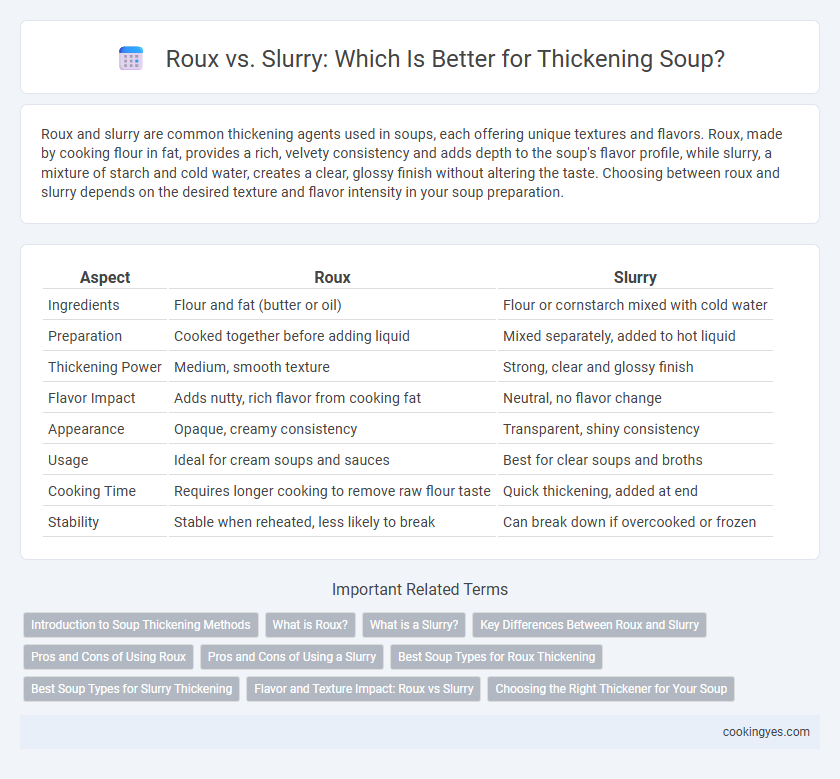Roux and slurry are common thickening agents used in soups, each offering unique textures and flavors. Roux, made by cooking flour in fat, provides a rich, velvety consistency and adds depth to the soup's flavor profile, while slurry, a mixture of starch and cold water, creates a clear, glossy finish without altering the taste. Choosing between roux and slurry depends on the desired texture and flavor intensity in your soup preparation.
Table of Comparison
| Aspect | Roux | Slurry |
|---|---|---|
| Ingredients | Flour and fat (butter or oil) | Flour or cornstarch mixed with cold water |
| Preparation | Cooked together before adding liquid | Mixed separately, added to hot liquid |
| Thickening Power | Medium, smooth texture | Strong, clear and glossy finish |
| Flavor Impact | Adds nutty, rich flavor from cooking fat | Neutral, no flavor change |
| Appearance | Opaque, creamy consistency | Transparent, shiny consistency |
| Usage | Ideal for cream soups and sauces | Best for clear soups and broths |
| Cooking Time | Requires longer cooking to remove raw flour taste | Quick thickening, added at end |
| Stability | Stable when reheated, less likely to break | Can break down if overcooked or frozen |
Introduction to Soup Thickening Methods
Roux and slurry are two fundamental soup-thickening methods essential in culinary techniques. Roux, a cooked mixture of flour and fat, creates a rich, velvety texture and adds depth of flavor while gradually thickening soups. Slurry, composed of cornstarch or flour mixed with cold water, offers a quick and clear thickening solution, ideal for lighter soups or when immediate thickening is needed.
What is Roux?
Roux is a classic thickening agent made by cooking equal parts flour and fat, typically butter, until it forms a smooth paste. It is essential in many soup recipes because it provides a rich, velvety texture and a subtle, toasted flavor that enhances the overall dish. Unlike a slurry, roux is cooked before adding liquid, which helps eliminate the raw flour taste and improves the soup's consistency.
What is a Slurry?
A slurry is a mixture of cold water and starch, commonly cornstarch or flour, used to thicken soups and sauces quickly. It is added towards the end of cooking to avoid clumping and provides a glossy, smooth texture without altering the soup's flavor. Compared to a roux, slurry requires less cooking time and imparts a lighter consistency.
Key Differences Between Roux and Slurry
Roux and slurry are two fundamental thickening agents used in soups, each with distinct properties and applications. Roux, made by cooking equal parts fat and flour, imparts a rich, nutty flavor and a smooth, velvety texture, making it ideal for creamy soups and sauces. Slurry, a mixture of cold water and starch such as cornstarch or arrowroot, thickens quickly without altering flavor, best suited for clear soups and avoiding cloudiness.
Pros and Cons of Using Roux
Roux, made from equal parts fat and flour cooked together, provides a rich, velvety texture and imparts a nutty flavor that enhances soup depth. It offers superior heat stability and smooth consistency, making it ideal for slow-simmered soups and sauces but requires precise cooking to avoid a raw flour taste or lumps. Roux thickens more evenly than slurry but demands more time and attention during preparation, which can be a drawback in quick cooking scenarios.
Pros and Cons of Using a Slurry
Using a slurry made from cornstarch and cold water offers quick thickening for soups without altering the flavor or color significantly, making it ideal for clear broths. However, slurry-thickened soups can become cloudy and may break down or thin out when reheated excessively, limiting heat stability. Unlike roux, slurries require careful stirring to prevent lumps and do not contribute to texture or richness.
Best Soup Types for Roux Thickening
Roux is ideal for thickening rich, creamy soups like gumbo, chowders, and bisques, providing a smooth, velvety texture and deep flavor due to its cooked flour and fat mixture. These soups benefit from roux's ability to create a stable, glossy consistency that enhances the overall mouthfeel and prevents lumping. Unlike slurry, roux works best in soups that require prolonged simmering to develop complex flavors and achieve the perfect thickness.
Best Soup Types for Slurry Thickening
Slurry thickening is ideal for clear soups like consommes, vegetable broths, and Asian-style soups such as hot and sour or miso soup, as it maintains clarity without cloudiness. It works best with soups that require a light texture and quick thickening without altering flavor, making it less suitable for creamy or dairy-based soups. When using slurry, cornstarch or arrowroot mixed with cold water is commonly employed to achieve a smooth consistency.
Flavor and Texture Impact: Roux vs Slurry
Roux enhances soup by adding a rich, nutty flavor and velvety texture through the slow cooking of flour and fat, creating depth and body. Slurry, made from cornstarch or flour mixed with water, thickens soups quickly without altering the flavor or adding richness, resulting in a clearer and lighter texture. Choosing roux or slurry depends on desired soup characteristics, with roux providing complex taste and creamy consistency, while slurry offers a neutral taste and smoother, thinner finish.
Choosing the Right Thickener for Your Soup
Roux and slurry are two popular thickening agents used in soups, each offering different textures and flavors. Roux, made from equal parts fat and flour cooked together, provides a rich, velvety consistency and adds depth to creamy soups and chowders. Slurry, a mixture of starch (such as cornstarch or potato starch) and cold water, thickens quickly without altering the soup's flavor, making it ideal for clear broths and lighter soups.
Roux vs Slurry for Thickening Infographic

 cookingyes.com
cookingyes.com